Minh Nhat Vu
Learning Human Motion with Temporally Conditional Mamba
Oct 14, 2025Abstract:Learning human motion based on a time-dependent input signal presents a challenging yet impactful task with various applications. The goal of this task is to generate or estimate human movement that consistently reflects the temporal patterns of conditioning inputs. Existing methods typically rely on cross-attention mechanisms to fuse the condition with motion. However, this approach primarily captures global interactions and struggles to maintain step-by-step temporal alignment. To address this limitation, we introduce Temporally Conditional Mamba, a new mamba-based model for human motion generation. Our approach integrates conditional information into the recurrent dynamics of the Mamba block, enabling better temporally aligned motion. To validate the effectiveness of our method, we evaluate it on a variety of human motion tasks. Extensive experiments demonstrate that our model significantly improves temporal alignment, motion realism, and condition consistency over state-of-the-art approaches. Our project page is available at https://zquang2202.github.io/TCM.
Improving Robotic Manipulation with Efficient Geometry-Aware Vision Encoder
Sep 19, 2025Abstract:Existing RGB-based imitation learning approaches typically employ traditional vision encoders such as ResNet or ViT, which lack explicit 3D reasoning capabilities. Recent geometry-grounded vision models, such as VGGT~\cite{wang2025vggt}, provide robust spatial understanding and are promising candidates to address this limitation. This work investigates the integration of geometry-aware visual representations into robotic manipulation. Our results suggest that incorporating the geometry-aware vision encoder into imitation learning frameworks, including ACT and DP, yields up to 6.5% improvement over standard vision encoders in success rate across single- and bi-manual manipulation tasks in both simulation and real-world settings. Despite these benefits, most geometry-grounded models require high computational cost, limiting their deployment in practical robotic systems. To address this challenge, we propose eVGGT, an efficient geometry-aware encoder distilled from VGGT. eVGGT is nearly 9 times faster and 5 times smaller than VGGT, while preserving strong 3D reasoning capabilities. Code and pretrained models will be released to facilitate further research in geometry-aware robotics.
Generating Actionable Robot Knowledge Bases by Combining 3D Scene Graphs with Robot Ontologies
Jul 15, 2025Abstract:In robotics, the effective integration of environmental data into actionable knowledge remains a significant challenge due to the variety and incompatibility of data formats commonly used in scene descriptions, such as MJCF, URDF, and SDF. This paper presents a novel approach that addresses these challenges by developing a unified scene graph model that standardizes these varied formats into the Universal Scene Description (USD) format. This standardization facilitates the integration of these scene graphs with robot ontologies through semantic reporting, enabling the translation of complex environmental data into actionable knowledge essential for cognitive robotic control. We evaluated our approach by converting procedural 3D environments into USD format, which is then annotated semantically and translated into a knowledge graph to effectively answer competency questions, demonstrating its utility for real-time robotic decision-making. Additionally, we developed a web-based visualization tool to support the semantic mapping process, providing users with an intuitive interface to manage the 3D environment.
Efficient Collision Detection for Long and Slender Robotic Links in Euclidean Distance Fields: Application to a Forestry Crane
Jul 02, 2025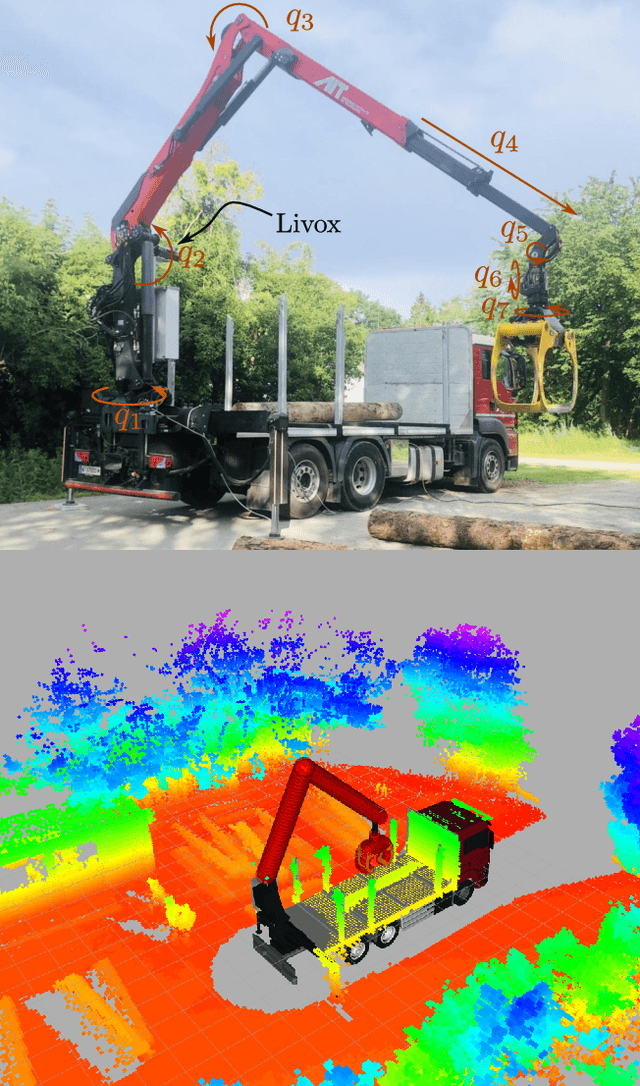
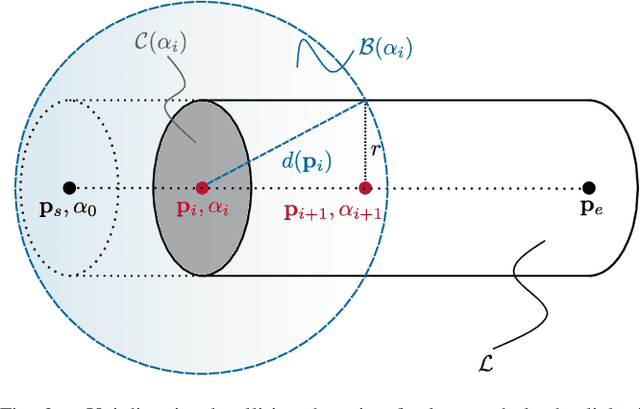
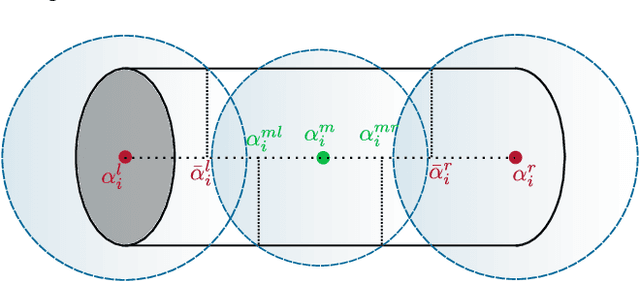
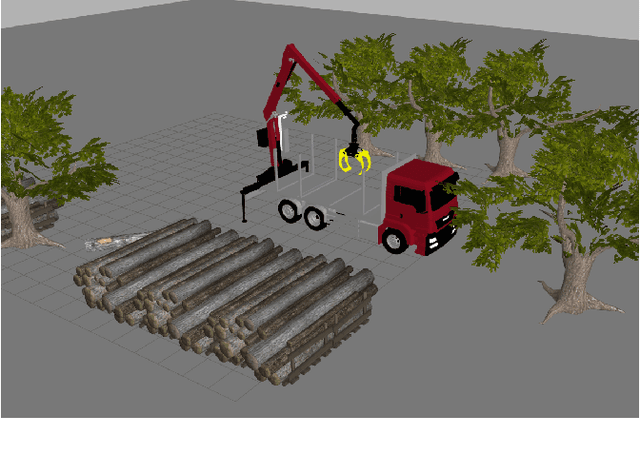
Abstract:Collision-free motion planning in complex outdoor environments relies heavily on perceiving the surroundings through exteroceptive sensors. A widely used approach represents the environment as a voxelized Euclidean distance field, where robots are typically approximated by spheres. However, for large-scale manipulators such as forestry cranes, which feature long and slender links, this conventional spherical approximation becomes inefficient and inaccurate. This work presents a novel collision detection algorithm specifically designed to exploit the elongated structure of such manipulators, significantly enhancing the computational efficiency of motion planning algorithms. Unlike traditional sphere decomposition methods, our approach not only improves computational efficiency but also naturally eliminates the need to fine-tune the approximation accuracy as an additional parameter. We validate the algorithm's effectiveness using real-world LiDAR data from a forestry crane application, as well as simulated environment data.
Learning Swing-up Maneuvers for a Suspended Aerial Manipulation Platform in a Hierarchical Control Framework
Jun 16, 2025Abstract:In this work, we present a novel approach to augment a model-based control method with a reinforcement learning (RL) agent and demonstrate a swing-up maneuver with a suspended aerial manipulation platform. These platforms are targeted towards a wide range of applications on construction sites involving cranes, with swing-up maneuvers allowing it to perch at a given location, inaccessible with purely the thrust force of the platform. Our proposed approach is based on a hierarchical control framework, which allows different tasks to be executed according to their assigned priorities. An RL agent is then subsequently utilized to adjust the reference set-point of the lower-priority tasks to perform the swing-up maneuver, which is confined in the nullspace of the higher-priority tasks, such as maintaining a specific orientation and position of the end-effector. Our approach is validated using extensive numerical simulation studies.
DoublyAware: Dual Planning and Policy Awareness for Temporal Difference Learning in Humanoid Locomotion
Jun 12, 2025Abstract:Achieving robust robot learning for humanoid locomotion is a fundamental challenge in model-based reinforcement learning (MBRL), where environmental stochasticity and randomness can hinder efficient exploration and learning stability. The environmental, so-called aleatoric, uncertainty can be amplified in high-dimensional action spaces with complex contact dynamics, and further entangled with epistemic uncertainty in the models during learning phases. In this work, we propose DoublyAware, an uncertainty-aware extension of Temporal Difference Model Predictive Control (TD-MPC) that explicitly decomposes uncertainty into two disjoint interpretable components, i.e., planning and policy uncertainties. To handle the planning uncertainty, DoublyAware employs conformal prediction to filter candidate trajectories using quantile-calibrated risk bounds, ensuring statistical consistency and robustness against stochastic dynamics. Meanwhile, policy rollouts are leveraged as structured informative priors to support the learning phase with Group-Relative Policy Constraint (GRPC) optimizers that impose a group-based adaptive trust-region in the latent action space. This principled combination enables the robot agent to prioritize high-confidence, high-reward behavior while maintaining effective, targeted exploration under uncertainty. Evaluated on the HumanoidBench locomotion suite with the Unitree 26-DoF H1-2 humanoid, DoublyAware demonstrates improved sample efficiency, accelerated convergence, and enhanced motion feasibility compared to RL baselines. Our simulation results emphasize the significance of structured uncertainty modeling for data-efficient and reliable decision-making in TD-MPC-based humanoid locomotion learning.
ReFineVLA: Reasoning-Aware Teacher-Guided Transfer Fine-Tuning
May 25, 2025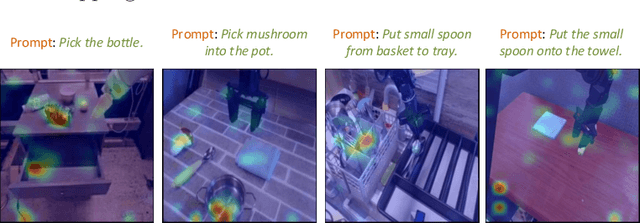



Abstract:Vision-Language-Action (VLA) models have gained much attention from the research community thanks to their strength in translating multimodal observations with linguistic instructions into robotic actions. Despite their recent advancements, VLAs often overlook the explicit reasoning and only learn the functional input-action mappings, omitting these crucial logical steps for interpretability and generalization for complex, long-horizon manipulation tasks. In this work, we propose \textit{ReFineVLA}, a multimodal reasoning-aware framework that fine-tunes VLAs with teacher-guided reasons. We first augment robotic datasets with reasoning rationales generated by an expert teacher model, guiding VLA models to learn to reason about their actions. Then, we use \textit{ReFineVLA} to fine-tune pre-trained VLAs with the reasoning-enriched datasets, while maintaining their inherent generalization abilities and boosting reasoning capabilities. In addition, we conduct an attention map visualization to analyze the alignment among visual attention, linguistic prompts, and to-be-executed actions of \textit{ReFineVLA}, showcasing its ability to focus on relevant tasks and actions. Through the latter step, we explore that \textit{ReFineVLA}-trained models exhibit a meaningful attention shift towards relevant objects, highlighting the enhanced multimodal understanding and improved generalization. Evaluated across manipulation tasks, \textit{ReFineVLA} outperforms the state-of-the-art baselines. Specifically, it achieves an average increase of $5.0\%$ success rate on SimplerEnv WidowX Robot tasks, improves by an average of $8.6\%$ in variant aggregation settings, and by $1.7\%$ in visual matching settings for SimplerEnv Google Robot tasks. The source code will be publicly available.
Model Tensor Planning
May 02, 2025



Abstract:Sampling-based model predictive control (MPC) offers strong performance in nonlinear and contact-rich robotic tasks, yet often suffers from poor exploration due to locally greedy sampling schemes. We propose \emph{Model Tensor Planning} (MTP), a novel sampling-based MPC framework that introduces high-entropy control trajectory generation through structured tensor sampling. By sampling over randomized multipartite graphs and interpolating control trajectories with B-splines and Akima splines, MTP ensures smooth and globally diverse control candidates. We further propose a simple $\beta$-mixing strategy that blends local exploitative and global exploratory samples within the modified Cross-Entropy Method (CEM) update, balancing control refinement and exploration. Theoretically, we show that MTP achieves asymptotic path coverage and maximum entropy in the control trajectory space in the limit of infinite tensor depth and width. Our implementation is fully vectorized using JAX and compatible with MuJoCo XLA, supporting \emph{Just-in-time} (JIT) compilation and batched rollouts for real-time control with online domain randomization. Through experiments on various challenging robotic tasks, ranging from dexterous in-hand manipulation to humanoid locomotion, we demonstrate that MTP outperforms standard MPC and evolutionary strategy baselines in task success and control robustness. Design and sensitivity ablations confirm the effectiveness of MTP tensor sampling structure, spline interpolation choices, and mixing strategy. Altogether, MTP offers a scalable framework for robust exploration in model-based planning and control.
GPU-Accelerated Motion Planning of an Underactuated Forestry Crane in Cluttered Environments
Mar 18, 2025



Abstract:Autonomous large-scale machine operations require fast, efficient, and collision-free motion planning while addressing unique challenges such as hydraulic actuation limits and underactuated joint dynamics. This paper presents a novel two-step motion planning framework designed for an underactuated forestry crane. The first step employs GPU-accelerated stochastic optimization to rapidly compute a globally shortest collision-free path. The second step refines this path into a dynamically feasible trajectory using a trajectory optimizer that ensures compliance with system dynamics and actuation constraints. The proposed approach is benchmarked against conventional techniques, including RRT-based methods and purely optimization-based approaches. Simulation results demonstrate substantial improvements in computation speed and motion feasibility, making this method highly suitable for complex crane systems.
RoboDesign1M: A Large-scale Dataset for Robot Design Understanding
Mar 09, 2025Abstract:Robot design is a complex and time-consuming process that requires specialized expertise. Gaining a deeper understanding of robot design data can enable various applications, including automated design generation, retrieving example designs from text, and developing AI-powered design assistants. While recent advancements in foundation models present promising approaches to addressing these challenges, progress in this field is hindered by the lack of large-scale design datasets. In this paper, we introduce RoboDesign1M, a large-scale dataset comprising 1 million samples. Our dataset features multimodal data collected from scientific literature, covering various robotics domains. We propose a semi-automated data collection pipeline, enabling efficient and diverse data acquisition. To assess the effectiveness of RoboDesign1M, we conduct extensive experiments across multiple tasks, including design image generation, visual question answering about designs, and design image retrieval. The results demonstrate that our dataset serves as a challenging new benchmark for design understanding tasks and has the potential to advance research in this field. RoboDesign1M will be released to support further developments in AI-driven robotic design automation.
 Add to Chrome
Add to Chrome Add to Firefox
Add to Firefox Add to Edge
Add to Edge